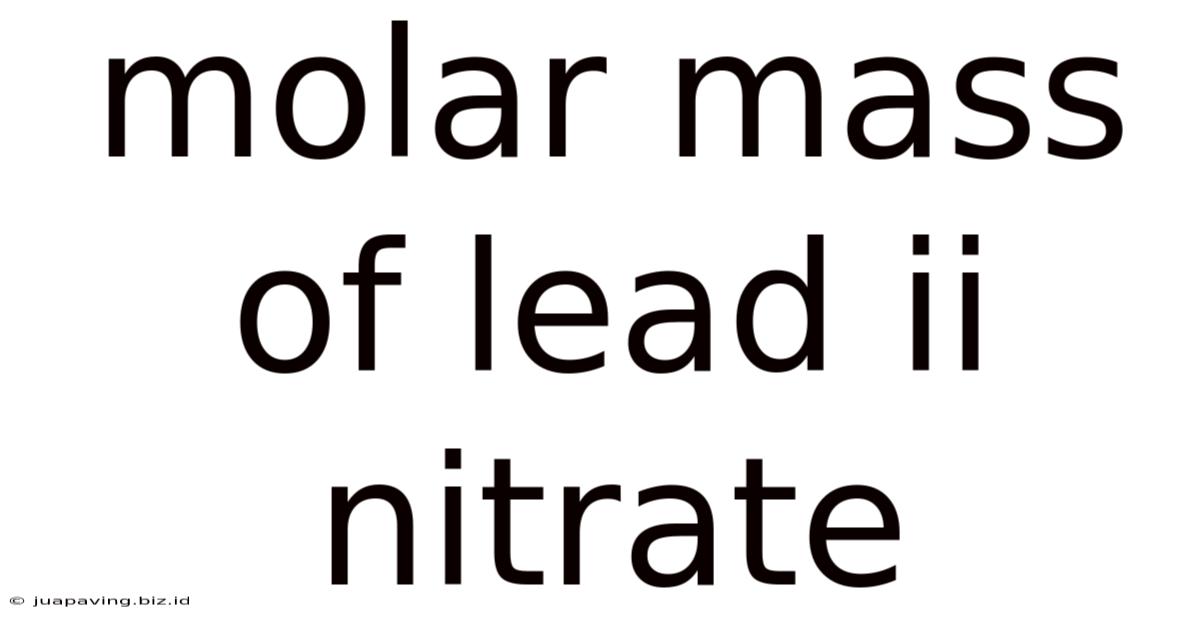Molar Mass Of Lead Ii Nitrate
Juapaving
May 14, 2025 · 4 min read

Table of Contents
Molar Mass of Lead(II) Nitrate: A Comprehensive Guide
Lead(II) nitrate, a crystalline inorganic compound with the chemical formula Pb(NO₃)₂, is frequently encountered in various chemical applications. Understanding its molar mass is crucial for accurate stoichiometric calculations, solution preparation, and numerous other chemical processes. This comprehensive guide delves into the detailed calculation of the molar mass of lead(II) nitrate, exploring the underlying principles and providing practical examples. We will also examine its properties and applications to further contextualize its importance.
Understanding Molar Mass
Before diving into the calculation, let's establish a clear understanding of molar mass. Molar mass is defined as the mass of one mole of a substance. A mole is a fundamental unit in chemistry representing Avogadro's number (approximately 6.022 x 10²³) of elementary entities, such as atoms, molecules, or ions. The molar mass is numerically equivalent to the average atomic mass of an element (expressed in atomic mass units, amu) or the sum of the atomic masses of the atoms in a molecule or formula unit (expressed in grams per mole, g/mol).
Calculating the Molar Mass of Lead(II) Nitrate
To calculate the molar mass of Pb(NO₃)₂, we need to consider the atomic masses of its constituent elements: lead (Pb), nitrogen (N), and oxygen (O). These atomic masses can be found on the periodic table. The standard values are approximately:
- Lead (Pb): 207.2 g/mol
- Nitrogen (N): 14.01 g/mol
- Oxygen (O): 16.00 g/mol
Now, let's break down the calculation step-by-step:
-
Lead (Pb): There is one lead atom in the formula unit of Pb(NO₃)₂, so its contribution to the molar mass is 207.2 g/mol.
-
Nitrogen (N): There are two nitrogen atoms in the formula unit (NO₃)₂, contributing 2 * 14.01 g/mol = 28.02 g/mol.
-
Oxygen (O): There are six oxygen atoms in the formula unit (2 * 3 = 6), contributing 6 * 16.00 g/mol = 96.00 g/mol.
-
Total Molar Mass: Adding the contributions of each element, we get the total molar mass of Pb(NO₃)₂:
207.2 g/mol (Pb) + 28.02 g/mol (N) + 96.00 g/mol (O) = 331.22 g/mol
Therefore, the molar mass of lead(II) nitrate is approximately 331.22 g/mol. This value is crucial for various chemical calculations, as we will see in the following sections.
Applications of Molar Mass in Lead(II) Nitrate Calculations
The molar mass of Pb(NO₃)₂ is a fundamental parameter in various chemical calculations. Let's explore some key applications:
1. Determining the Mass of a Given Number of Moles
Suppose we need to determine the mass of 0.5 moles of Pb(NO₃)₂. Using the molar mass, we can calculate this as follows:
Mass = Moles × Molar Mass = 0.5 mol × 331.22 g/mol = 165.61 g
Therefore, 0.5 moles of lead(II) nitrate weighs approximately 165.61 grams.
2. Determining the Number of Moles from a Given Mass
Conversely, if we have 100 grams of Pb(NO₃)₂, we can determine the number of moles:
Moles = Mass / Molar Mass = 100 g / 331.22 g/mol ≈ 0.302 moles
Thus, 100 grams of lead(II) nitrate contain approximately 0.302 moles.
3. Stoichiometric Calculations in Chemical Reactions
Molar mass plays a vital role in stoichiometric calculations. For instance, consider a reaction involving Pb(NO₃)₂. Knowing its molar mass allows us to determine the amounts of reactants and products involved in a balanced chemical equation based on mole ratios.
4. Solution Preparation
When preparing solutions of a specific concentration (e.g., molarity), the molar mass of Pb(NO₃)₂ is essential. Molarity (M) is defined as moles of solute per liter of solution. To prepare a 1M solution of Pb(NO₃)₂, you would need to dissolve 331.22 grams of Pb(NO₃)₂ in enough solvent to make 1 liter of solution.
Properties of Lead(II) Nitrate
Understanding the properties of lead(II) nitrate helps contextualize its molar mass's importance. Some key properties include:
- Appearance: Colorless, transparent crystals.
- Solubility: Highly soluble in water.
- Toxicity: Lead(II) nitrate is highly toxic. It is a heavy metal compound and should be handled with extreme care, using appropriate safety measures. Ingestion or inhalation can lead to serious health problems.
- Reactivity: It decomposes upon heating, producing lead(II) oxide, nitrogen dioxide, and oxygen.
Safety Precautions
Due to the inherent toxicity of lead(II) nitrate, it's crucial to handle it with extreme care. Always wear appropriate personal protective equipment (PPE), including gloves, eye protection, and a lab coat. Work in a well-ventilated area or under a fume hood to minimize exposure to potentially harmful fumes. Proper disposal procedures should be followed, adhering to all relevant environmental regulations.
Conclusion
The accurate calculation of the molar mass of lead(II) nitrate is crucial for various chemical calculations and applications. Understanding its molar mass (approximately 331.22 g/mol) allows for precise determination of the mass from a given number of moles, vice-versa, and enables accurate stoichiometric calculations in chemical reactions and precise solution preparation. However, always remember the importance of safety precautions when handling this toxic compound. This detailed guide has provided a thorough understanding of the molar mass of Pb(NO₃)₂ and its significance in the field of chemistry. Remember to always consult reliable sources and safety data sheets before handling any chemicals.
Latest Posts
Latest Posts
-
Number In Words From 1 To 100
May 14, 2025
-
What Is 96 Inches In Feet
May 14, 2025
-
What Percentage Is 35 Out Of 40
May 14, 2025
-
Electricity Is Measured In What Unit
May 14, 2025
-
Is A Pencil A Conductor Or Insulator
May 14, 2025
Related Post
Thank you for visiting our website which covers about Molar Mass Of Lead Ii Nitrate . We hope the information provided has been useful to you. Feel free to contact us if you have any questions or need further assistance. See you next time and don't miss to bookmark.